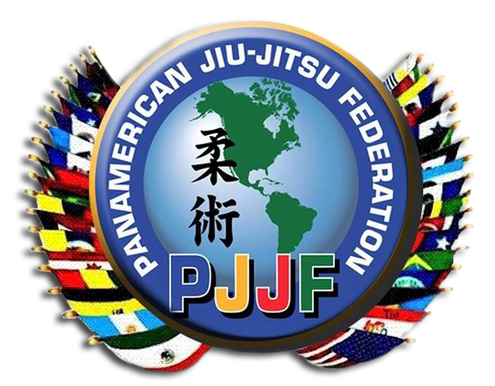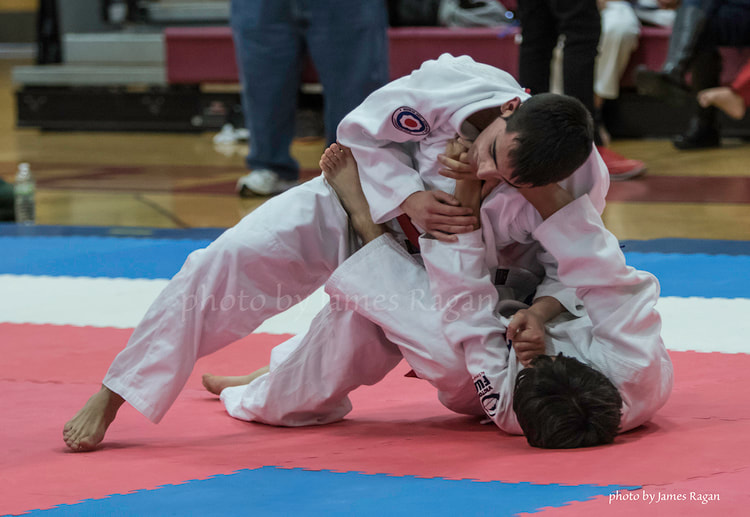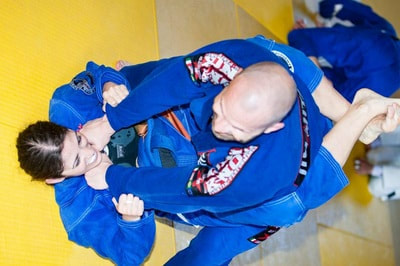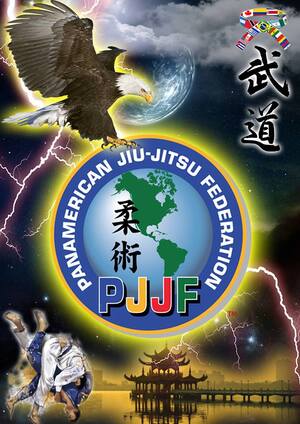PJJF's
BJJ - GRAPPLING
Continental Program
Panamerican Jiu-Jitsu Federation (PJJF) tm proudly presents its Continental System - Rank Requirements for BJJ-Grappling.
PJJF's BJJ - GRAPPLING COMMITTEE
Brian Walsh, Chairman
· Bruce R. Bethers
· Jose Higino Alves Nunes
· Eduardo B. Pieroni
· Fernando Yamasaki
· Gene LeBell
· Gokor Chivichyan
. James B. Wadley
· Antonio la Salandra
· Earl DelValle
· Domingos Nunes
· Jeff Santella
· Jeff Rhodes
· Jeffrey Cook
· John Newton
· Michael Antonides
· Alireza Davoodi
· Nadeem Ansari
. Rafael Jovet-Ramos
. Micheal Rosenquist
- Overview of Brazilian Jiu-Jitsu -
Brazilian jiu-jitsu is a martial art, combat sport, and a self defense system that focuses on grappling and especially ground fighting. Brazilian jiu-jitsu was formed from Kodokan Judo ground fighting (newaza) fundamentals that were taught by a number of individuals including Takeo Yano, Mitsuyo Maeda and Soshihiro Satake. Brazilian jiu-jitsu eventually came to be its own art through the experiments, practices, and adaptation of the judo knowledge of Carlos and Hélio Gracie, who then passed their knowledge on to their extended family.
BJJ promotes the concept that a smaller, weaker person can successfully defend against a bigger, stronger assailant by using proper technique, leverage, and most notably, taking the fight to the ground, and then applying joint-locks and chokeholds to defeat the opponent. BJJ training is used for sport grappling tournaments (gi and no-gi). Sparring (commonly referred to as "rolling") and live drilling play a major role in training, and a premium is placed on performance, especially in competition, in relation to progress and ascension through its ranking system.
Since its inception in 1882, its parent art of judo was separated from older systems of Japanese ju-jitsu by an important difference that was passed on to Brazilian jiu-jitsu: it is not solely a martial art, it is also a sport; a method for promoting physical fitness and building character in young people; and, ultimately, a way (Do) of life.
History Origins Geo Omori opened the first jujutsu / judo school in Brazil in 1909. He would go on to teach a number of individuals including Luiz França. Later, Mitsuyo Maeda was one of five of the Kodokan's top groundwork (newaza) experts that judo's founder Kano Jigoro sent overseas to demonstrate and spread his art to the world. Maeda had trained first in sumo as a teenager, and after the interest generated by stories about the success of Kodokan Judo at contests with other jujutsu schools that were occurring at the time, became a student of Jigoro Kano. Maeda left Japan in 1904 and visited a number of countries giving "judo" demonstrations and accepting challenges from wrestlers, boxers, savate fighters and various other martial artists before eventually arriving in Brazil on November 14, 1914.
Gastão Gracie was a business partner of the American Circus in Belém. In 1916, Italian Argentine circus Queirolo Brothers staged shows there and presented Maeda. In 1917,Carlos Gracie, the eldest son of Gastão Gracie, watched a demonstration by Maeda at the Da Paz Theatre and decided to learn judo. Maeda accepted Carlos as a student and Carlos learned for a few years, eventually passing his knowledge on to his brothers. Sibling Hélio Gracie gradually further developed Gracie Jiu Jitsu as a softer, pragmatic adaptation from judo that focused on ground fighting, as he was unable to perform many judo moves that require direct opposition to an opponent's strength.
Outside Japan, however, this distinction was noted even less. Thus, when Maeda and Satake arrived in Brazil in 1914, every newspaper announced their art as being "jiu-jitsu" despite both men being Kodokan judoka.
Divergence from Kodokan rules. Since judo was introduced to Brazil there have been changes in the rules of sport judo – some to enhance it as a spectator sport, and some for improved safety. Several of these rule changes have greatly de-emphasised the groundwork aspects of judo, and others have reduced the range of joint locks allowed and when they can be applied. Brazilian jiu-jitsu did not follow these changes to judo rules (and there is no evidence that some of the rules were ever used, such as the win by pin/osaekomi or by throw), and this divergence has given it a distinct identity as a grappling art, while still being recognizably related to judo. Other factors that have contributed towards the stylistic divergence of BJJ from sport judo include the Gracies' desire to create a national martial art, the influence of Brazilian culture, and the Gracies' emphasis on full-contact fighting.
BJJ permits all the techniques that judo allows to take the fight to the ground. These include judo's scoring throws as well as judo's non-scoring techniques that it refers to as "skillful takedowns" (such as the flying armbar). BJJ also allows any and all takedowns from wrestling, sambo, or any other grappling arts including direct attempts to take down by touching the legs. BJJ also differs from judo in that it also allows a competitor to drag his opponent to the ground, and even to drop to the ground himself provided he has first taken a grip. Early Kodokan judo was similarly open in its rules (even permitting an athlete to simply sit on the mat at the beginning of a match), but has since become increasingly restrictive in comparison. BJJ has also become more sports oriented and has eliminated techniques such as picking up an opponent from the guard and throwing him.
BJJ - GRAPPLING
Continental Program
Panamerican Jiu-Jitsu Federation (PJJF) tm proudly presents its Continental System - Rank Requirements for BJJ-Grappling.
PJJF's BJJ - GRAPPLING COMMITTEE
Brian Walsh, Chairman
· Bruce R. Bethers
· Jose Higino Alves Nunes
· Eduardo B. Pieroni
· Fernando Yamasaki
· Gene LeBell
· Gokor Chivichyan
. James B. Wadley
· Antonio la Salandra
· Earl DelValle
· Domingos Nunes
· Jeff Santella
· Jeff Rhodes
· Jeffrey Cook
· John Newton
· Michael Antonides
· Alireza Davoodi
· Nadeem Ansari
. Rafael Jovet-Ramos
. Micheal Rosenquist
- Overview of Brazilian Jiu-Jitsu -
Brazilian jiu-jitsu is a martial art, combat sport, and a self defense system that focuses on grappling and especially ground fighting. Brazilian jiu-jitsu was formed from Kodokan Judo ground fighting (newaza) fundamentals that were taught by a number of individuals including Takeo Yano, Mitsuyo Maeda and Soshihiro Satake. Brazilian jiu-jitsu eventually came to be its own art through the experiments, practices, and adaptation of the judo knowledge of Carlos and Hélio Gracie, who then passed their knowledge on to their extended family.
BJJ promotes the concept that a smaller, weaker person can successfully defend against a bigger, stronger assailant by using proper technique, leverage, and most notably, taking the fight to the ground, and then applying joint-locks and chokeholds to defeat the opponent. BJJ training is used for sport grappling tournaments (gi and no-gi). Sparring (commonly referred to as "rolling") and live drilling play a major role in training, and a premium is placed on performance, especially in competition, in relation to progress and ascension through its ranking system.
Since its inception in 1882, its parent art of judo was separated from older systems of Japanese ju-jitsu by an important difference that was passed on to Brazilian jiu-jitsu: it is not solely a martial art, it is also a sport; a method for promoting physical fitness and building character in young people; and, ultimately, a way (Do) of life.
History Origins Geo Omori opened the first jujutsu / judo school in Brazil in 1909. He would go on to teach a number of individuals including Luiz França. Later, Mitsuyo Maeda was one of five of the Kodokan's top groundwork (newaza) experts that judo's founder Kano Jigoro sent overseas to demonstrate and spread his art to the world. Maeda had trained first in sumo as a teenager, and after the interest generated by stories about the success of Kodokan Judo at contests with other jujutsu schools that were occurring at the time, became a student of Jigoro Kano. Maeda left Japan in 1904 and visited a number of countries giving "judo" demonstrations and accepting challenges from wrestlers, boxers, savate fighters and various other martial artists before eventually arriving in Brazil on November 14, 1914.
Gastão Gracie was a business partner of the American Circus in Belém. In 1916, Italian Argentine circus Queirolo Brothers staged shows there and presented Maeda. In 1917,Carlos Gracie, the eldest son of Gastão Gracie, watched a demonstration by Maeda at the Da Paz Theatre and decided to learn judo. Maeda accepted Carlos as a student and Carlos learned for a few years, eventually passing his knowledge on to his brothers. Sibling Hélio Gracie gradually further developed Gracie Jiu Jitsu as a softer, pragmatic adaptation from judo that focused on ground fighting, as he was unable to perform many judo moves that require direct opposition to an opponent's strength.
Outside Japan, however, this distinction was noted even less. Thus, when Maeda and Satake arrived in Brazil in 1914, every newspaper announced their art as being "jiu-jitsu" despite both men being Kodokan judoka.
Divergence from Kodokan rules. Since judo was introduced to Brazil there have been changes in the rules of sport judo – some to enhance it as a spectator sport, and some for improved safety. Several of these rule changes have greatly de-emphasised the groundwork aspects of judo, and others have reduced the range of joint locks allowed and when they can be applied. Brazilian jiu-jitsu did not follow these changes to judo rules (and there is no evidence that some of the rules were ever used, such as the win by pin/osaekomi or by throw), and this divergence has given it a distinct identity as a grappling art, while still being recognizably related to judo. Other factors that have contributed towards the stylistic divergence of BJJ from sport judo include the Gracies' desire to create a national martial art, the influence of Brazilian culture, and the Gracies' emphasis on full-contact fighting.
BJJ permits all the techniques that judo allows to take the fight to the ground. These include judo's scoring throws as well as judo's non-scoring techniques that it refers to as "skillful takedowns" (such as the flying armbar). BJJ also allows any and all takedowns from wrestling, sambo, or any other grappling arts including direct attempts to take down by touching the legs. BJJ also differs from judo in that it also allows a competitor to drag his opponent to the ground, and even to drop to the ground himself provided he has first taken a grip. Early Kodokan judo was similarly open in its rules (even permitting an athlete to simply sit on the mat at the beginning of a match), but has since become increasingly restrictive in comparison. BJJ has also become more sports oriented and has eliminated techniques such as picking up an opponent from the guard and throwing him.











